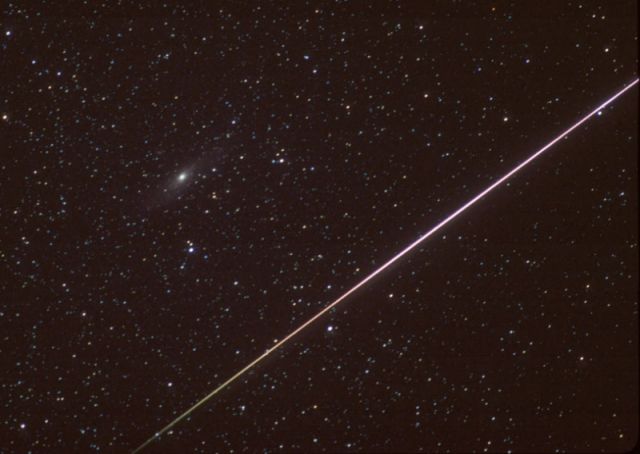
|
Credit & Copyright: Rick Scott
Explanation:
On August 13,
while counting Perseid meteors under
dark, early morning Arizona skies,
Rick Scott set out to photograph their fleeting
but fiery trails.
The equipment he used included a telephoto lens and fast
color film.
After 21 pictures he'd caught only two meteors, but luckily
this was one of them.
Tracking the sky, his ten minute long exposure shows a
field of many stars in our own Milky Way galaxy, most too
faint to be seen by the unaided eye.
Flashing
from lower left to upper right, the bright meteor would
have been an easy eyeful though,
as friction with Earth's atmosphere
vaporized the hurtling grain of
cosmic sand, a piece of dust from Comet
Swift-Tuttle.
Just above and left of center, well beyond the stars of
the Milky Way, lies the island universe
known as M31 or the Andromeda galaxy.
The visible meteor trail begins about 100 kilometers
above Earth's surface, one of the closest celestial objects
seen in the sky.
In contrast, Andromeda, about 2 million light-years
away, is the most distant object easily visible to the naked-eye.
|
January February March April May June July August September October November December |
| ||||||||||||||||||||||||||||||||||||||||||||||||
NASA Web Site Statements, Warnings, and Disclaimers
NASA Official: Jay Norris. Specific rights apply.
A service of: LHEA at NASA / GSFC
& Michigan Tech. U.
Based on Astronomy Picture
Of the Day
Publications with keywords: Perseids - meteor - Andromeda galaxy - M 31
Publications with words: Perseids - meteor - Andromeda galaxy - M 31
See also:
- APOD: 2025 August 25 Á The Meteor and the Star Cluster
- APOD: 2025 August 21 Á Mostly Perseids
- APOD: 2025 August 20 Á Perseid Meteors from Durdle Door
- APOD: 2025 August 12 Á Perseids from Perseus
- APOD: 2025 August 6 Á Meteor before Galaxy
- APOD: 2025 August 3 Á Milky Way and Exploding Meteor
- Hubble s Andromeda Galaxy Mosaic
